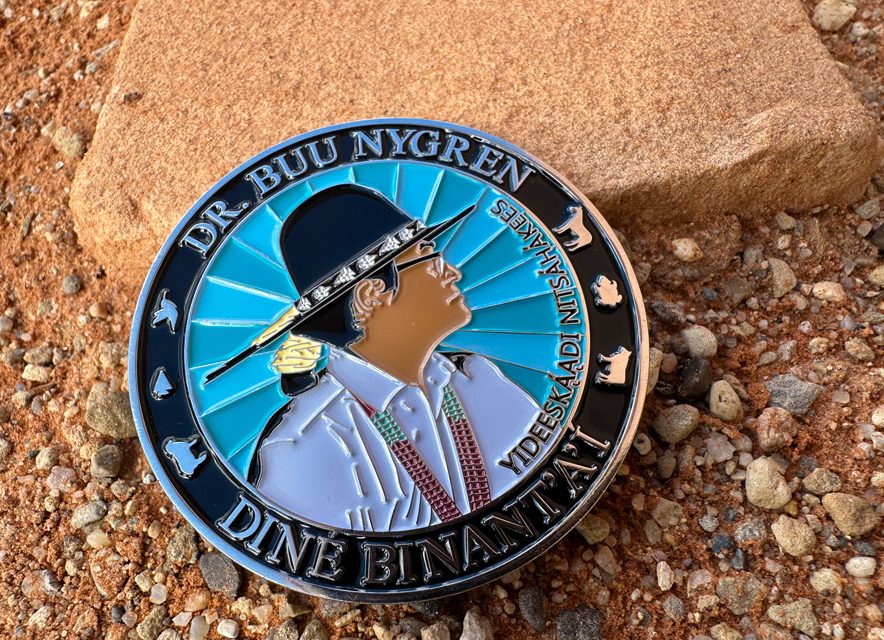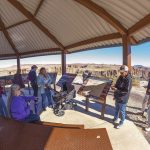
Nygren buries facts in fine print

Navajo Times | Krista Allen
President Buu Nygren’s challenge coin, measuring approximately 2.5 inches in diameter, features an image of himself alongside livestock and “Diné Binant’a’í” on May 18, 2025.
The president’s 28-page response to Naabik’íyáti’ delivers spin, sidesteps and silence on spending
TÓ ŁIZHIN, N.M.
Eight days after President Buu Nygren promised to correspond written responses to questions from the Naabik’íyáti’ Committee, he paid his dues delicately, deceiving the committee and Diné with calculated evasion.
In a May 16 letter to Speaker Crystalyne Curley, Nygren submitted responses to questions that went unanswered during the May 8 Naabik’íyáti’ Committee meeting. The 28-page letter, titled “Responses to Questions Raised at Naabik’íyáti’ Committee on May 8, 2025,” stated that the answers were provided for inquiries requiring more technical or detailed explanations than could be offered on the floor.
Land yachts with no receipts
With four separate questions under “vehicles” answered, the last two cut to the point: “What was the total amount to purchase these vehicles? Where was the money to purchase these vehicles from?”
Most would expect a dollar sign and account for funding. Instead, on page 13, Nygren’s legal team came out of left field: “Our office did not purchase the vehicles. The vehicles were purchased and are owned by the Navajo Nation.” An earlier response said Nygren’s office has eight vehicles, “including six EPS (executive protection service) vehicles.”
Still, no cash numbers. Just more circular language: “Our office pays the same user rates as all branches to rent the vehicles.”
Short. Bittersweet. Evasive. The way his legal counsel vetted the response raises doubts about whether it was ever meant to bring clarity to the Diné.
The Nygren News May edition boasts $2.3 million spent on “25 brand-new Jeep Wagoneers” for senior centers, funded with ARPA monies. $2.3 million divided by 25 is $92,000. According to Jeep, a 2025 Wagoneer starts at $62,945, the Grand Wagoneer L Series III can cross $110,000. At those margins, the purchased fleet wasn’t white Cadillacs with blue “official use only” seals, but close enough. Why Jeeps? The nearest Jeep dealership for maintenance is 114 miles away, in Farmington, from the Fleet Management Department in Tségháhoodzání. Amigo Chevrolet, Rico Auto Complex, and Champion Ford are less than 28 miles away.
Navajo Nation could’ve turned the president’s office into Graceland, dressed in tribal-funded flair. At those numbers, even Elvis Presley would’ve pushed for Escalades instead. Not even an “oral quote” like Nygren News was given for the eight president’s office vehicles. Nonetheless, Vice President Richelle Montoya hasn’t experienced the new car smell with these governmental rollouts.
Legal oversight
The chief legal counsel for the Navajo Nation is Bidtah N. Becker. She is responsible for providing strategic legal guidance, managing legal risks, and ensuring compliance with laws and regulations.
However, the purpose of the Navajo Nation Ethics in Government Law is to require accountability to the people of the Navajo Nation by their elected, appointed, and assigned public officials and employees in exercising the authority vested or to be vested with them as a matter of public trust. “The people are entitled to have complete confidence in the loyalty and integrity of their government,” according to the Navajo Nation Ethics and Rules Office. Nygren, Becker, and the legal team technically answered the laundry list of questions from Naabik’íyáti’, yet at the cost of integrity and transparency.
Presidential challenge coins without a price tag
Among the simplest questions posed: “Those coins you hand out, how many were ordered and what did they cost?” Nygren’s legal team danced with the devil to curate his response on pages 23 and 24.

Navajo Times | Krista Allen
President Buu Nygren’s challenge coin, measuring approximately 2.5 inches in diameter, features the Navajo Nation seal and the inscription “Dr. Buu Nygren Navajo Nation President” on the reverse side.
“Challenge coins have a long-standing tradition in military and government service, dating back to World War I. They are typically custom-designed medallions that represent an organization, unit, or leader. Over time, they’ve become widely adopted by military branches, federal agencies, tribal governments, and elected officials-including U.S. Presidents, Governors, and Members of Congress.
“In diplomatic and leadership settings, challenge coins are often exchanged when two leaders meet. The gesture symbolizes mutual respect as leaders meet. The gesture symbolizes mutual respect, partnership, and a shared commitment to service. It’s a meaningful way to build goodwill and strengthen relationships.
“The use of challenge coins by the President of the Navajo Nation is not new. Former President Jonathan Nez also had challenge coins during his administration. What’s important to clarify is that no Navajo Nation funds were used to purchase the current administration’s coins—a fact that can be verified with the Office of the Controller.
“These coins serve as a cultural bridge between the Navajo Nation and other governments and dignitaries. They are a symbol of leadership, sovereignty, and nation-to-nation diplomacy.”
Not only did he unnecessarily drag Nez in his answer, but he maneuvered around numbers, for how many coins were ordered or cost. Nez at least had the formality of adding “vice president” to his coin.
Nygren’s statement diverts, “no Navajo Nation funds were used to purchase coins” – a clever way not to give a definitive funding source. The coins claimed to be a “bridge between the Navajo Nation and other governments and dignitaries,” but how many were ordered and what they cost remains a mystery to people.
Interior publication without a ledger
Perhaps most contentious on page 23 was the response’s defense of Nygren News. Asked how much it costs per month, the to-the-penny response was “1.17 per copy,” followed by saying it’s “significantly less that the Navajo Times or the Gallup Independent charge for their papers.”
The Gallup Independent sells for 50 cents in most editions. The “cost per copy” doesn’t include insurance, mileage, and salary for carriers who disperse the periodicals. Also, there was no breakdown of the cost for content creation, layout, design, licensing, permits, shipping, and staff’s time, to name a few.
His answer continued, “What sets Nygren News apart is that it is not charged to the people,” with the assumption, they don’t pay Uncle Sam his cut in taxes. So, technically, when the periodical used federal money, people around the U.S. chipped in. Though Nygren News is not a new concept, citing the response, it’s not a “necessary” tool for transparency.
Nygren stated, “It helps us tell our own story, directly to our communities, without outside filter,” seeming to challenge freedom of the press and becoming a fertile opportunity for propaganda.
The May edition of Nygren News highlights his “1,000 Homes Initiative,” on the cover page, followed by pages 3, 4, 5,11, and 21. Yet, the Naabik’íyáti’ Committee revealed reality.
“Now we got a bigger problem. We got to figure out how to get them power and water and sewer, and septic,” Nygren said May 8 in the Council Chamber. His administration lacked even basic cost estimates for utility hookups – electrical lines, sewer systems, and potable water – for many of the housing units already delivered. Those homes, built under the banner of the 1,000 Home Initiative, now sit idle, uninhabitable, and lack funding. A clear example of the need for an outside filter.
Hundreds of homes rolled out without a completed plan to make them livable. He said this after he claimed, “We solved the housing problem.”
Nygren ended his responses with: “The fact remains, this publication is an affordable, accountable, and much-needed way to keep our people informed.”
While he runs an official Facebook, X, Instagram, Navajo Times ads, Thursday updates on Spotify, Apple “Podcasts,” KNDN, KTNN, KGAK, Diné College’s 92.1 FM, and Navajo Technical University’s 107.3 FM, a numerical cost breakdown of Nygren News has not been given.
To read the full article, please see the May 22, 2025, edition of the Navajo Times.








 Highway 264,
Highway 264, I-40, WB @ Winslow
I-40, WB @ Winslow